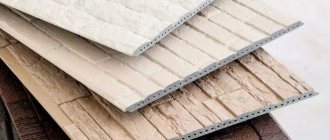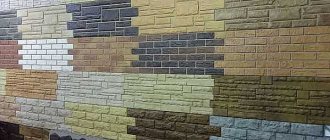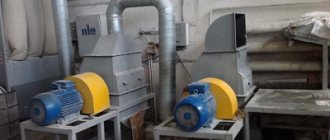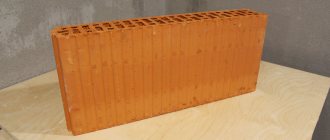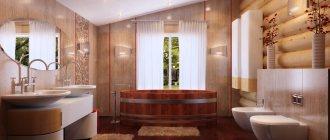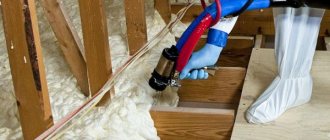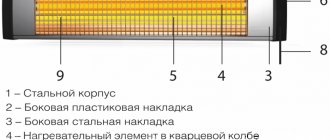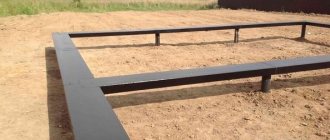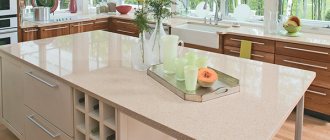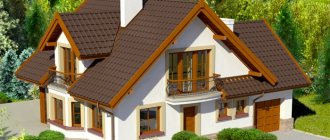Having decided on the façade cladding material and choosing siding as a façade finish, you will need to choose the appropriate option from all its variety. Siding panels are made of metal and plastic; externally, the planks and cladding may not differ much, but they differ in quality and technical characteristics.
Which siding is better, metal or vinyl, is a question that is quite difficult to answer without considering and comparing the advantages and disadvantages of both types. The materials are based on steel alloy or modified polymer (vinyl). Each has its own advantages, features and performance characteristics.
Metal siding
Advantages
- High fire safety class, fire resistance.
- Long service life.
- Mechanical qualities vary depending on the thickness of the steel sheet; strength is much higher than that of polyvinyl chloride analogues.
- Resistance of the coating and protective and decorative layer to mechanical damage.
- Environmental safety, non-toxic material.
Cladding with metal siding is a good option for houses that are operated in aggressive climatic conditions and environments.
The disadvantages of metal siding are its higher cost compared to its vinyl counterparts. In addition, the material has high thermal conductivity, which reduces the energy-saving qualities of the cladding.
Alloy steel sheet is susceptible to corrosion processes, but special layers of protection (galvanization, primer, decorative protective layer) significantly reduce the risk of corrosion and rusting of the metal.
Burnout
Both cheap and expensive siding sheets are susceptible to aging when exposed to sunlight. Some fade the next season, while others gradually fade from year to year. This is an irreversible process.
Basically everything depends on the color of the material. More expensive models are painted over the entire thickness, while analogues are painted only on top.
The original color takes on a completely different shade from the sun, because each dye has different resistance to ultraviolet radiation. And buying green siding, by next year it can turn into swamp gray.
Why should the toilet and bath be done together and the main disadvantages of an isolated solution
Vinyl siding
Advantages
- Durable material, service life is calculated in decades.
- Resistance to aggressive chemical environments and atmospheric corrosion.
- High thermal insulation rates, protecting the building from freezing.
- Moisture resistance, absence of fungus and mold on the surface.
- Non-flammable, however, the material melts at high temperatures.
- Lower cost compared to steel panels.
Vinyl siding is the best choice for private houses and cottages. Some types and names are not inferior to their metal counterparts in strength and durability. But melting at high temperatures and lower resistance to mechanical stress significantly reduce the scope of application.
Static properties
Vinyl flooring is synthetic. And as you know, dust, hair, fluff, etc. stick to all synthetic materials.
Dirt will constantly stick to the finished facade, which is quite difficult to wash off. And you will have to spray antistatic agent over the entire surface area. And after a few months you need to take a rag again and wash the facade.
How to choose - metal or vinyl panels?
When making a comparison, it is worth recommending vinyl siding for owners of private real estate, objects that do not have high requirements for fire safety and vandal-proof qualities of the cladding.
Metal facade siding is highly durable and mechanically resistant to damage. It is suitable for facilities where it is necessary to meet increased fire safety requirements - it does not burn or melt during fires or high temperatures.
The material is widely used not only in private construction, but also in the construction of industrial, commercial and public buildings.
The main disadvantages of siding are generally known - it is significantly inferior in terms of efficiency to simple types of facade cladding. At the same time, in terms of quality, it is preferable to many varieties of high-quality finishes with layers of insulation and waterproofing.
Expensive consumables
When selecting and purchasing a coating, the consultant will definitely offer auxiliary devices for proper installation. It won't work without the components, and the client agrees.
Prices for materials from the same manufacturer as the selected siding are significantly higher than those without a “known name.” Their quality is the same, but consultants operate on the basis that if you take another manufacturer, the warranty on the cladding disappears.
The main disadvantages of aerated concrete that you need to know about before starting construction of a house
Advantages of siding cladding
Despite the fact that the technical characteristics of the types of facing strips made of metal and vinyl differ from each other, they are externally similar and have certain common advantages.
- Metal and vinyl cladding is suitable for creating ventilated facades with the possibility of additional insulation and waterproofing of walls.
- Modern types of siding are reliably protected from external influences.
- Metal. Metal strips include zinc and aluminum for increased ductility and anti-corrosion properties. Steel profiles are galvanized and primed, with a special protective and decorative layer; some manufacturers provide the materials with multi-layer protection on each side.
- Vinyl. It is created on the basis of a modified polymer. Special additives are added to vinyl to improve technical properties. Single-color dyeing based on the thickness of the material increases color fastness. Special decorative coatings and textures imitating timber, logs, stone or brickwork significantly improve aesthetic qualities.
What to choose from
What types of siding can scientific and technological progress offer today? There are relatively few of them.
- Wood.
- Vinyl.
- Metal.
- Steel or galvanized.
- Siding made of zinc.
- Cement (fiber cement).
Siding always looks good. Knowing the features will perhaps convince you or broaden your horizons and help improve your country house, any extension, or fence. Only positive reviews from home owners and professional builders indicate the quality of the invention. This is a small victory of scientific and technological progress over corrosion and inflation, which nothing will erase from history.
Comparative characteristics
- Durability . Metal is preferable to vinyl.
- Corrosion . A steel sheet may rust if the protective layers are damaged; the polymer coating is not affected by corrosion.
- Linear expansion . Vinyl has it, but metal does not.
- Operating temperature range . Approximately the same for both types.
- Soundproofing . Vinyl cladding outperforms metal cladding in terms of noise protection.
- Antistatic properties . Metal coatings are high, vinyl coatings are low.
- UV protection . The materials differ little in terms of protection from ultraviolet radiation.
- Installation work . Vinyl siding is easier to install.
- Color solutions . Metal counterparts usually have a wider color palette of shades.
- Price . Products made from steel alloys are much more expensive than their vinyl counterparts.
Accessories
To secure the metal siding and generally complete the cladding, additional equipment will be required. Before installation, you must additionally stock up on:
- strips - corner (both internal and external), connecting, slope and initial, finishing;
- moldings;
- drainage;
- platbands.
Additional elements for siding
Both components and sheets must be produced by the same manufacturer: this facilitates their joining. Some components are installed before installation, some after. Therefore, before proceeding, you should carefully read the instructions.
Aesthetic qualities
From an aesthetic point of view, the disadvantages of vinyl siding are the loss of brightness of the shade of richly colored coatings. However, the problem is solved by using expensive color stabilizers, which affects the cost. The risk of sunburn from ultraviolet radiation is higher.
The aesthetic disadvantages of metal siding are that the coating is less similar to the imitation object (beams of logs, timber, stone or brickwork, boards). The cladding surface retains the metallic exterior, despite the decorative protective layer and the panel profile of the slats.
Equipment
Panel covering involves not only the installation of the main panels, but also the additional design of their joints, corners, window and door openings.
Siding components include the following elements :
- starting bar . The element from which installation of the cladding begins serves as the basis for inserting the initial strips of siding;
- J-profile . It is an element for decorating spotlights, framing corners, window and door openings;
- outer corner Gives a finished look to outer corners;
- internal corner . Frames internal corners;
- connecting profile (H-profile). Serves to design the joints of panels;
- finishing bar . Serves to decorate the upper edge of the cladding;
- window slat . Along with the J-profile, it is used for framing windows and door openings;
- platband . Sometimes used instead of J-profile.
NOTE!
All components must be purchased together with the main panels from the same manufacturer.
In this case, they will match in color, their fastenings will match perfectly.
Equipment
Consumer demand
Facade siding is vinyl or metal, which is better, the answer to the question is ambiguous, especially taking into account consumer choice in different regions of the Russian Federation. In most cases, construction companies and consumers prefer vinyl. The trend is most obvious in Moscow and the Moscow region, where about three-quarters of buyers prefer vinyl facade finishing; in the south of the Russian Federation the demand is equally high.
In areas with harsh climatic conditions, winds and cold, and high humidity, the relationship between consumer choice is not so obvious. A much larger percentage of buyers prefer metal siding to vinyl. In some areas, steel panel cladding strips are used by more than half of consumers.
Typical installation mistakes
Although installing a façade with siding cannot be called the most difficult method of cladding houses, nevertheless, in practice it is very often possible to encounter some typical mistakes that violate both aesthetic qualities and protective characteristics. Here are the main ones:
- Installation in the wrong direction. Always pay attention to the direction of the siding locks and whether the panel is inserted from bottom to top or top to bottom. If this parameter is not taken into account, there may be moisture in the cavities of the locks, which will lead to corrosion or damage to the panels when water freezes and expands. When purchasing, be sure to ask the seller or manufacturer how to properly install this panel.
- Screwing screws into the siding lock to the limit. When temperatures drop, the panels may expand, causing them to move or become damaged. While this may not be so significant with metal panels, plastic can be very seriously deformed. Therefore, when twisting, some margin is always left. One or two millimeters will be enough - this is the ideal balance between fastening strength and safety for the material. Also, do not screw screws into the very edge of the perforated areas. This is also due to the temperature shift of the material: you need to create a small space for the free movement of the panels. Screw the screws strictly into the center of the lock.
- Use of non-galvanized screws. Metal coated with a layer of zinc does not corrode for more than 50 years. The facade, in turn, is one of the most vulnerable areas of the house to rust, since it bears the main load from atmospheric phenomena. Always attach siding to the facade using galvanized self-tapping screws - regardless of the material.
- No sheathing. Almost any wall has some irregularities. Accordingly, your siding will repeat these irregularities, provided that you mount it directly to the wall. The lathing will help to avoid this, and will also create the necessary ventilation, which is very necessary to maintain a normal microclimate without unnecessary accumulation of moisture.
- Installation of vinyl siding at different times of the year. There are different types of siding for finishing facades, but vinyl is the most vulnerable to temperature influences. It fades very quickly in the sun and loses its original color. Therefore, if you install one part of it, for example, in June, and the other in August, the color of the different panels may differ significantly. For the same reason, you should always order siding from the same batch. Dividing the cladding into several stages - for example, doing one side in the summer and the other in the fall - is not the best idea. This is due to the fact that even the same manufacturer in different batches can allow minor deviations from the declared color scheme. This becomes especially noticeable if you are going to tile, for example, the main house, garage and bathhouse at different times.
- Screwing screws into the body of the panel itself, and not into special grooves (locks). Many people think that this way they can secure the siding more reliably, but this achieves the exact opposite effect. The panel will sooner or later fail, and its appearance will be hopelessly ruined.
Where to buy all types of siding
offers different types and names of siding on the Russian market. Products are presented from different manufacturers under various brand names. The choice of metal and vinyl materials of Russian and foreign production is large, which allows you to purchase optimal solutions for the features and style of the architectural object.
We also offer design and installation services for building structures and systems. The work is performed by qualified engineering and technical personnel. Materials are transported to sites in Moscow and the Moscow region using our own delivery service.
Preparatory stage
Cladding using lathing does not require leveling the surface to an “ideal” state. But this does not mean that the walls do not need to be prepared for work. Moreover, when siding is only part of the overall installation of a curtain wall with insulation.
Therefore, it is necessary to clean the surface of old finishing materials, remove hanging elements of utility lines, remove signs and lamps, dismantle ebbs and canopies. The facade must be completely free.
If the facade is plastered, then it must be cleaned of crumbling areas, primed and, if necessary, leveled with mortar.
It is sometimes difficult to clean old plasterSource allcosmoshop.ru
Brick walls must be checked for cracks, their nature must be determined, the causes must be eliminated and repaired with a repair compound.
The walls of a house that was built a long time ago should be checked for fungus and moss damage. This is especially true for the basement, first floor and canopy area on the north side or in “solid” shade.
The scope of work to prepare surfaces for cladding determines whether cladding can be carried out in winter. Sheathing a wooden house with metal siding or vinyl and WPC can be done in winter if the house is new. If it is necessary to carry out “wet” repair work with solutions and liquid compounds, this is not possible.
